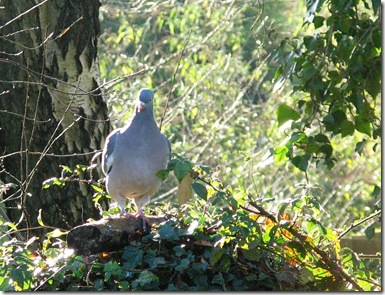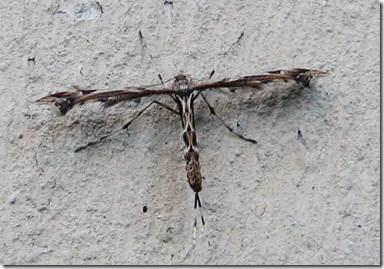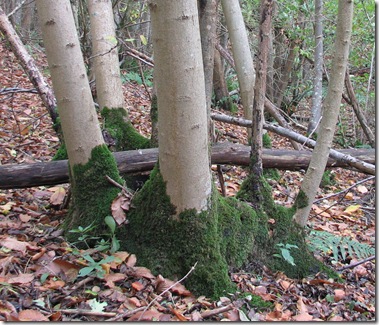I continue to follow, albeit rather wearily, the ash dieback debate through many authors in newspapers, magazines and blogs, both here and in other countries.
There now seems to be a general consensus that infection is by wind borne spores and there is little that can be done to stop the progress of the disease. It is thought like that up to 10% of ash trees will be resistant to the disease and that these may be an important resource in ensuring the ash's future recovery.
There has also been much debate about the pros and cons of large tree planting schemes and it is frequently pointed out that Britain has proportionately less woodland cover than almost anywhere else in Europe.
This has brought the issue of natural regeneration rather than deliberate planting to the fore. In East Sussex where I live I know of many places, usually abandoned fields, that have regenerated to secondary woodland surprisingly quickly and, judging by the size of the saplings I have seen in some televised tree planting schemes (maybe only from seed this year), regeneration may be almost as fast, if not faster than planting. Though it does not do much for the tree nursery trade, or other human engagement with tree planting schemes.
I think the regeneration point is well-illustrated by this from Julian Roughton as a comment on a Guardian article: In 2005 Suffolk Wildlife Trust bought a 40 acre field alongside an ancient woodland reserve - no trees were planted to see what would naturally emerge. Now there are something like half a million young ash trees many ten feet tall as well as birch, oak, field maple, hawthorn and blackthorn. Despite no tree planting thousands of young ash saplings are now affected by ash die back. Hopefully some of those half a million young ash trees will emerge with some resistance but where they die other tree seedlings are likely to take hold.
There also seems to be a conflation of trees with woodland. We cannot have woodland without trees, of course, but woodland is much much more than just trees. Not only does it have important open spaces like glades and rides, it has something known as an edge ranging from almost bare ground through shorter grasses and herbs to scrub and various shrubs unlikely to survive in closed canopy conditions. This woodland edge often contains the greatest biodiversity and is much loved by species like nightingales, dormice and pearl-bordered fritillaries, all species often associated with woodland but preferring scrub and more open areas. There are also many species that spend part of their life within the tree canopy and part in the sheltered sunshine of the woodland edge.
The chair of The Woodland Trust, Clive Anderson, pointed out is an Observer article yesterday that with natural regeneration "It can take a while for trees to force their way through grasses, low-growing plants and scrub, but they will get there in the end." True maybe, though self-sown trees, as I said above, can grow very quickly. However, grasses, low-growing plants and scrub are just as much part of the natural environment, and just as important to wildlife as woodlands.
As has often been remarked, nature is dynamic and is constantly undergoing change and alteration. Woodland may be termed climax vegetation but trees eventually die and the space is created which is the other side of the forest coin. I have long thought that we are failing to appreciate the diversity and complexity of wildlife if we compartmentalise the landscape too much: that is a wood, that is a heath, that is a field. Until recently housing or commercial developments were allowed to go right up to the edge of an ancient woodland, but now a buffer of 30 metres or more is often specified. This buffer is to provide a wonderful mixed edge of "grasses, low-growing plants and scrub" on which the life of the wood is partly dependent.
It would be silly to suggest that all tree planting schemes should stop, but it would be nice to see more natural regeneration schemes such as that by the Suffolk Wildlife Trust mentioned above being promoted, studied and discussed. If a field were to become available for tree planting, for example, one half could be reserved for natural regeneration.
Two famous examples of this are the Geescroft and Broadbalk wildernesses at the Rothamsted Experimental Station in Hertfordshire. Here arable fields were abandoned in the 1880s and have long been regenerated woodlands. There is an interesting comment about this in Footprints in the Soil (2006) edited by Benno Warkentin: These two historic Rothamsted sites illustrate the very considerable potential for carbon sequestration of simply allowing the steady state vegetation to re-establish itself. Actively afforesting arable land will obviously be effective, but the more the soil is perturbed, the longer the benefit will take to materialize."
This weekend I was watching a tree planting day in Leicestershire on TV. The small saplings were being planted in what was obviously stubble from a recent grain crop. I did wonder, in these days of grain shortages, about the pros and cons of turning arable fields into woods. And I also wondered about the transactional details of the arrangement. There was no discussion of this on the TV programme. Via some quick research I found out that arable land in Leicestershire is on offer at around £9,000 per acre ... I assume a farmer would not want to arrange for extensive tree planting on arable sites unless there was some sort of financial return far beyond the scope of the kinds of grants offered by the government for farm management with wildlife in mind.
One final point, while many pests and diseases have been transported from their natural homes to somewhere else, I suspect that pathogens like ash dieback are often a natural phenomenon and that many plant species have gone through the kind of reversal now afflicting ash trees. It just underlines that our human perspectives are often little longer than the average lifetime.


